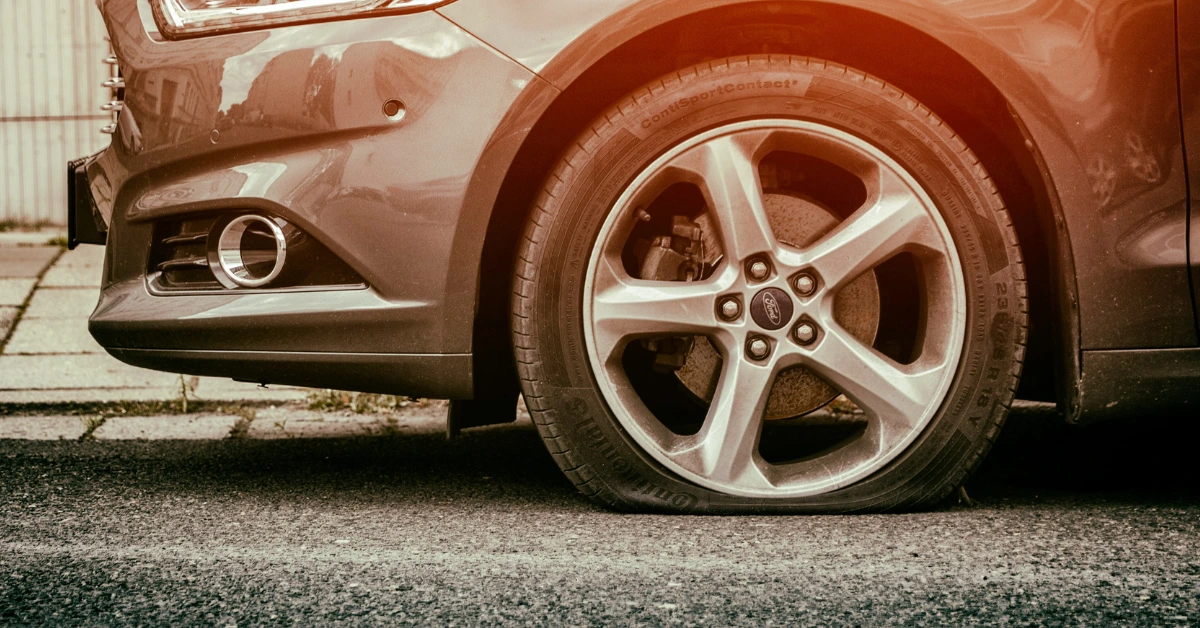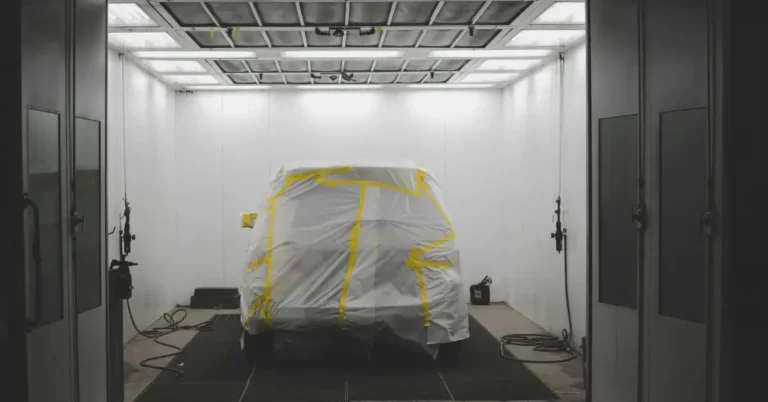We can all imagine the sinking feeling as your vehicle suddenly pulls to one side, and the thumping sound confirms your suspicion: a flat tire.
It often happens at the least convenient times, leaving us to deal with tire damage and the ensuing delays.
Understanding how it can affect your car’s handling and knowing the steps to manage the situation safely are important – and that’s what we will go through today.
How to behave when an accident with your tire happens is necessary. So put your Seat Belt on and listen carefully.
Recognizing a Car With Flat Tire
When we’re on the road, a car with flat tire can quickly turn into a bad situation. That’s why it’s essential to catch the early signs before you’re stranded roadside.

Warning Signs
There’s no mistaking the rumble and flapping sound when our tire loses air. If we feel vibrations or difficulty in steering, our car may be signaling a loss of air pressure. While driving, a sudden shift in how the car handles or a noticeable lack of traction may mean tread wear has led to a blowout.
We need to stay alert to these changes to avoid the risks of driving on a flat tire.
Tire Pressure Monitoring System
Most vehicles today are equipped with a Tire Pressure Monitoring System (TPMS) which alerts us the moment our air pressure drops below a safe point. If this warning light illuminates, it indicates that a tire is significantly underinflated and needs our attention.
Trusting our TPMS ensures we maintain optimal tire pressure and traction, safeguarding us against the dangers of an unnoticed flat tire.
Immediate Steps
A sudden loss of control, a thumping noise, and the sinking realization that we’re dealing with a car with flat tire.
It’s critical to handle the situation with calm precision, ensuring safety and efficiency. Here’s what we need to do straight away.
Pulling Over Safely
First things first: activate your hazard lights.
This alerts other drivers to our trouble, giving them the chance to make room for us to handle our car with flat tire.
We must then slow down gradually, avoiding any abrupt maneuvers. Look for a flat, stable surface to park on, preferably away from traffic. Engage the parking brake to secure the vehicle before we proceed to the next steps.
Assessing the Damage
Once we’re safely parked, it’s time to assess the damage to the tire. If it’s a small puncture, a temporary fix might be possible and a spare tire can get us back on the road.
However, if the damage is severe, calling a tow truck or roadside assistance is our safest bet. Remember, it’s about getting back on the road safely, not just quickly.
Changing a Flat Tire
When we’re dealing with a car with flat tire, our safety and efficiency depends on using the correct tools and executing a series of steps with confidence.
Quick action is key, but so is ensuring the task is done properly.
Using the Right Tools
Before we get started, let’s make sure we have everything we need. Our toolkit should include a jack, a lug wrench, and a piece of wood to secure the jack.
Of course, we should also have our spare tire, which ideally should be regularly checked for proper inflation.
It’s wise to keep a flashlight and the owner’s manual in our car at all times, as you never know when you might need them.

Step-by-Step Procedure
- Find a Safe Location:
If we encounter a puncture, we should pull over to a flat, stable surface, away from traffic. - Prepare the Car:
Before lifting it, apply the parking brake and place the wood beneath the jack to prevent slippage. - Loosen Lug Nuts:
Using the lug wrench, turn the lug nuts counterclockwise just enough to break their resistance. - Use the Jack:
With the jack properly positioned (consult your owner’s manual for the specific location), raise the car until the flat tire is off the ground. - Remove the Lug Nuts and Tire:
Take off the lug nuts completely and replace the flat tire with the spare. - Secure the Spare:
Screw the lug nuts by hand onto the wheel studs, then tighten them in a crisscross pattern with the wrench once the car is lowered. - Lower the Jack:
Carefully bring the car back down to the ground and give the lug nuts another pull with the wrench to ensure they’re snug.
By following these steps, we can efficiently manage a car with flat tire. It’s not a pleasant experience, but being prepared makes all the difference.
After Replacing a Tire
When we’re dealing with a car with a flat tire, replacing it solves one problem, but what comes afterward is just as crucial. Maintaining tire health ensures our safety and the vehicle’s performance.
Tire Inspection
Once we’ve replaced our tire, carefully inspecting the new one is vital. We must check the tire pressure to ensure it aligns with the manufacturer’s recommendations, as incorrect pressure can lead to uneven tire wear or another flat. Meanwhile, checking tread depth is essential to confirm that our new tire can grip the road effectively and provide a smooth ride.

Professional Assessment
Taking our car to a mechanic or tire shop for a professional assessment can’t be underestimated.
These experts can verify alignment to avoid uneven tire wear and possible issues with steering. They’ll also give valuable advice on tire maintenance, like when to rotate our tires, to extend the lifespan of the new tire. Remember, a spare tire is a temporary solution, and proper tire care after installation is necessary for both efficiency and our peace of mind on the road.
Preventing Flat Tires
Facing the inconvenience of a car with flat tire.
A flat tire can turn a good day into a strenuous one, but a few simple practices can help us steer clear of such trouble.
Let’s discuss how we can prevent flat tires and smooth our ride.
Regular Tire Inspection
We should make it a habit to inspect our tires for signs of wear or damage visually. Spotting an issue early can prevent a flat tire down the road.
- Tire Pressure: It’s crucial to keep our tires inflated to the manufacturer’s recommended level. Overinflation and underinflation can both lead to tire damage and eventual flats. Check Frequency Recommended Monthly
- Tire Tread: Inspect the tread for depth and pattern. Worn tread or uneven wear patterns can increase the risk of a puncture.
Mind Your Driving Habits
Our driving habits significantly influence tire health.
- Avoid potholes and sharp objects.
- Take it easy on corners and brakes to avoid unnecessary stress on our tires.
Routine Maintenance:
- Tire Rotation: This helps ensure even tire wear. A good rule of thumb is to rotate our tires every 5,000 to 10,000 miles.
- Alignment and Balancing: Proper alignment and balancing of our tires protect them from irregular wear.

Precautions
We should always be mindful of where we park and drive to avoid debris that can cause damage. It’s also smart to keep our brakes in tip-top shape; well-maintained rotors and brake lines play a role in preventing tire wear.
By taking care and keeping an eye out, we boost our chances of avoiding a Car with flat tires. Safe driving, Mate!
FAQ
Is it OK to drive your car with a flat tire?
You might be wondering if driving on a damaged tire ruins the tire?” The answer is yes. You damage your car and the wheel when you drive your car on a flat tire. This leads to poor handling and control, which increases the likelihood of causing an accident.
What to do if car has flat tyre?
Once you’re sure you’ve located a safe place, you need to come to a stop and apply the handbrake. Select first gear (or P, if it’s an automatic car), switch on your hazard lights and turn off the engine. It’s important that you’re on flat ground, as your car will roll if you’re on uneven ground.
What does it mean when a car has a flat tire?
A flat tire (British English: flat tyre) is a deflated pneumatic tire, which can cause the rim of the wheel to ride on the tire tread or the ground potentially resulting in loss of control of the vehicle or irreparable damage to the tire.
What about you? I hope you haven’t had experiences with flat tires.
But if you have anyways we would like to hear your story – write us an Mail or Comment under this post; see you next time when it says again…
…Let´s Ride!







